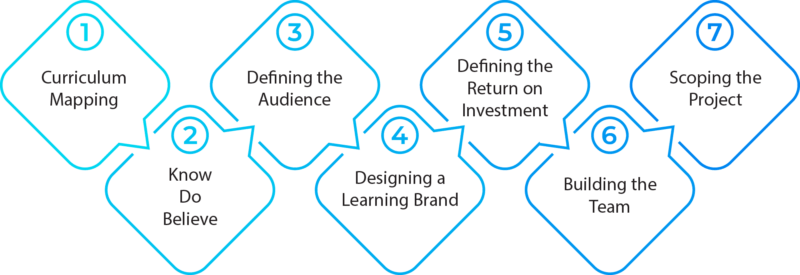L&D Synergy: The Importance Of Combining Learning Experience Design And Brand Identity
This article is part of a series focused on the Seven Elements of Needs Analysis. The Elements are: Curriculum Mapping, Know/Do/Believe, Defining the Audience, Designing a Learning Brand, Defining the Return on Investment, Building the Team, and Scoping the Project.

What you are about to read is a fable. The company, AshCom, is fictional, but the learning challenges faced by Kathryn, AshCom’s CLO, and her team are real and commonly shared by learning teams in corporations, non-profits, associations, and education. It is our hope that you will be able to connect with the characters, their challenges, and the solutions they discover. Building and following a needs analysis system is vital to the success of the learning opportunities we create.

Kick Things Off With Curriculum Mapping
Sunshine streamed through the glass window of the second story conference room. Kathryn was encouraged. Her brightness was due to more than just the warm, sunny day; AshCom’s learning team was making good progress as they conducted a complete learning needs analysis.
The acquisition of Globex brought the combined workforce to 6,000 people and had disrupted what they thought would be their path forward for several years. But her team responded well and was systematically working its way through the right questions in what seemed like the right order.
They began with Curriculum Mapping as suggested by Amy who, as a consultant, had watched it work in other companies. Michael, the former academic and now Kathryn’s learning strategist, pointed her to the three buckets of KNOW, DO, BELIEVE as a way of categorizing the objectives for the learning they would build. Maggie, who had been at AshCom for over 20 years and had the most institutional knowledge, helped Kathryn think through what their team needed to know about the 4,500 current AshCom employees and the 2,500 Globex employees who would soon be joining them. Kathryn might not be able to get to the granular level she wanted on each learner, but Maggie’s experience and wisdom were helpful in sorting through what they could know.
Alisha's Insights
The next big insight came from Alishia. She was the most recent addition to the learning team. Two years earlier, Alishia graduated from Texas A&M University with a Bachelor of Science degree in Instructional Training and Design. When Kathryn first interviewed Alishia, she was struck by her passion for learning and more specifically, for learners themselves. She wanted to see people grow and develop. Her love for education was her strength.
Of course, it didn’t hurt that Alishia had a 3.8 GPA and came with the highest recommendations from her professors. Plus, Alishia had been accepted into an M.ED. program in Educational Technology that both demonstrated her commitment to continuous learning and assisted Kathryn and her team with staying current on the latest technology and trends.
The big insight for Alishia did not, however, come from her knowledge of learning theory or her technical expertise. On that day, she drew from another source.
Sharing Their Findings
Kathryn called a half day meeting to review their progress to date and to clarify additional questions they might address as they worked through their needs analysis. She gave each team member 15 minutes to update everyone on progress to date. Amy presented a spread sheet on the Curriculum Mapping process but also showed a graphic of a road that made clear their progress, milestones that still needed to be complete, and the final destination. Michael had a PowerPoint on the three learning buckets of KNOW, DO, BELIEVE and the progress made so far in putting courses in each bucket as well as identifying some unaddressed learning needs.
Maggie reviewed a series of images of people in different roles with different education and experience levels and talked about where they were in terms of identifying their learners. There was still a long way to go and, as Maggie said at the end, this process probably should be ongoing.
The team followed up with some good clarifying questions and then Kathryn asked an open-ended question. “What’s next?”
Alishia wondered out loud, “Branding? Marketing?”
Michael couldn’t resist. He teased good-naturedly, “Are you in the wrong meeting? They are on the other end of the building.”
Kathryn encouraged Alishia to continue to think out loud and not worry about whether it was right. The others had seen her do this before. Sometimes it led nowhere, but sometimes it led to an idea that led to another really good idea once the team could all think about it together.
Learning Perceptions
“So, here’s what popped into my head,” said Alishia. “We have a path to follow. We have the three buckets. And we are learning about our learners. How will learners think about us? Or maybe more specifically, how will learners think about learning?”
Alishia paused. Everyone could see she was in the middle of a thought and not really asking for answers. She continued, “You all know that I learned instructional design at Texas A&M. What you might not know is that I minored in marketing. I wasn’t sure that I would find the job I wanted in L&D, so I did the marketing minor as a sort of backup plan. That might have been my parents’ idea.”
She continued, “In my master’s program, I’m starting to think that part of learner engagement has to involve building a brand with learners. We have to ‘market’ learning if we want learners to actively engage and seek out opportunities to learn. We have to think about how we will launch this new initiative and build enthusiasm and even anticipation for it.”
Enhanced Knowing, Doing, And Believing
Alishia took a few more seconds and said, “What if we thought of the learning we will create as a generic product and the 6,000 learners as potential consumers? We’ve already made a lot of progress creating our path, filling our buckets, and knowing our audience better. Shouldn’t we spend some time thinking about the learners’ experience? Even beyond what they will learn, shouldn’t we be asking what will their experience be? How can we try to make that the best possible?”
Maggie jumped in. “We have the AshCom brand standards, so that is a place to start. Are you saying we should have different branding for learning?”
“I don’t know,” said Alishia. “Maybe we use what we have as a basis and enhance them. Get more creative with them. I guess what I’m saying is that if we want people to grow and develop, they need to be learning. Their enhanced knowing, doing, and believing needs to match the goals of AshCom for sure, but we also need to think about how they experience the learning. If they aren’t enthusiastic, they won’t be driven to learn. And if they don’t have a great experience, the learning won’t stick, and they won’t seek it out.”
How Do You Engage Learners BEFORE Day One?
Kathryn liked where this was going. Seeking to summarize, she said, “What I hear you saying is that we need to keep two words in front of us.” She stood up and wrote, “LEARNER EXPERIENCE” on the white board. “If we lose track of this, we could potentially lose the attention of learners.”
Alishia responded, “Yes. Well, that’s a start. But I don’t think that’s all. We have to think about the learner experience when they are in a module for sure. We also have to use good instructional design principles and have learning that is creative and engaging. But I think what I’m trying to say is that we have to think about engaging learners even before they are learning. That’s what I meant by marketing¾how we let them know what’s coming and invite them to participate and be part of something great.”
“You want us to plan now for how we are going to communicate with learners before asking them to learn anything,” said Amy. “I’ve seen other companies do this well. Their learning team put in a lot of time thinking about how to brand their learning so that their learners’ expectations were high when there was an opportunity to learn. In other words, they worked hard to build quality products, but they also worked hard to communicate that quality to learners. In the cases I can think of, it was helpful in increasing retention and involvement. I can probably get permission to share some of those efforts if that would be helpful.”
eLearning & Brand Identity
Michael was looking at his phone but not because his mind was somewhere else. He was flipping through definitions of “branding” until he came to one that was clear to him. Such things came naturally to his academically-inclined mind. He raised his hand, a habit that made his colleagues giggle. When he had everyone’s attention, he read, “Branding: the art of aligning what you want people to think of your product with what people actually think of your product.”
“That’s helpful,” said Maggie. “We have to pay attention to more than just learning modules and courses. Also, we have to think hard about how we communicate to learners and then listen carefully to what they tell us. We think we create great learning opportunities, and we want them to think that too.”
“I suspect,” said Kathryn, still standing at the white board, “that begins long before someone is actually taking a module or participating in a discussion group. I heard at least two more good questions that have to be answered on the needs analysis journey.” She circled the words “LEARNER EXPERIENCE?” which she had written a few minutes earlier. She added “BRANDING/MARKETING?”
Creating The Branding Style Guide
The team started, but did not complete, a conversation about tone, style, and how learning would be branded and how that fit with AshCom as a company and specific audiences inside the company. Would their communication and learning be traditional, highly stylized, industrial? Which style might best connect with which group? Would their tone be funny or serious? calming or intense? conversational or scholarly?
The temptation was to talk about a specific topic or module. But Alishia, backed by Kathryn, nudged them back to the broader question of their learning brand and what the learner would experience.
The four-hour meeting went 23 minutes longer than expected. This was not typical for meetings led by Kathryn, but she felt that the importance of the topic and its timeliness at this stage made it worth it. She also gained an even deeper appreciate for Alishia’s abilities.
Conclusion
To read the rest of the chapters in this series on Needs Analysis and to see Kathryn and her team take on the other Essentials, please download the eBook How To Change The Way You Approach Needs Analysis: A Story Around The 7 Essential Elements. You can also join the webinar to nail your training needs analysis and master the essentials.


